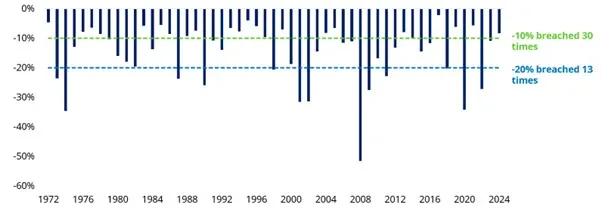Major Asset Owners Double Down on Private Markets Amid Rising Economic and Geopolitical Risks
| For Amaya Uriarte | 0 Comentarios

Major asset owners (LAOs) remain confident that their portfolios are well-positioned to withstand a variety of shocks over the next year. However, according to the latest Large Asset Owner Barometer 2025 published by Mercer, they perceive greater vulnerability compared to the previous year regarding several key risks over the next 12 months, including geopolitical risks (35% vs. 31% in 2024), inflation (31% vs. 22%), and monetary tightening (30% vs. 23%). In fact, over a three- to five-year horizon, perceived vulnerability to most risks has shown a slight increase.
In particular, regulatory risks during this period were cited by 32% of LAOs, marking a significant rise from 20% in the previous survey. This reflects growing uncertainty among asset owners about the future direction of regulation after a year marked by major political shifts and their potential impact on portfolios.
“Equity, fixed income, and currency markets are experiencing extreme volatility due to trade tensions, but based on our data, we see that major asset owners are positioned for the long term and generally remain calm about short-term market movements. That said, in the coming year they plan to make strategic portfolio adjustments, as they did last year, to mitigate risks and seize identified opportunities,” says Eimear Walsh, European Director of Investments at Mercer.
Positioning and Asset Allocation
According to Mercer’s report, over the past year LAOs have taken various steps to protect their portfolios, including adjusting fixed income allocation duration (53%) and modifying geographic asset exposure (47%). Notably, nearly half (45%) of respondents increased their allocation to private markets, a trend expected to continue into 2025.
Looking ahead to the next 12 months, 47% expect to increase portfolio allocations to private debt/credit, while 46% plan to boost allocations to infrastructure. This trend is especially pronounced among the largest asset owners; 70% of those managing over $20 billion intend to increase private debt/credit allocations, and 63% plan to invest more in infrastructure.
“Only five percent—one in twenty—of surveyed asset owners manage their investments entirely in-house. In an increasingly complex investment environment, we see strong appetite among major asset owners to outsource investment management, with the more complex asset classes often being handled by external teams,” notes Rich Nuzum, Executive Director of Investments and Global Chief Investment Strategist at Mercer.
Optimism Toward Domestic Markets
While generally confident in their resilience, European asset owners show greater concern about risks than their U.S. counterparts: 43% of European LAOs believe their portfolios are vulnerable to geopolitical threats over the next 3–5 years, compared to 18% in the U.S.
Unlike major asset owners in the U.S. and the U.K., European asset owners appear more optimistic about investing in domestic equities. 34% of Europe-based LAOs expect to increase their allocations to European equities over the next 12 months. On average, LAOs in the U.S. and the U.K. are more likely to reduce their allocations to domestic equity markets.
There is also evidence that European LAOs, which may have previously had lower exposure to private markets than their U.S. peers, are now looking to close that gap. 48% of European LAOs allocated to private markets in the past 12 months, compared to 27% of those based in the U.S.
Focus on AI
More than two-fifths (43%) of major asset owners surveyed believe that artificial intelligence will be a highly influential factor shaping the macroeconomic environment over the next 5 to 10 years, ahead of geopolitics (34%) and energy transition/climate change (34%). Despite this view, more than two-thirds (69%) of LAOs say they have not yet implemented or started developing an AI/GenAI policy.
Another key trend is the increasing incorporation of sustainable investment objectives among asset owners, though climate transition goals are declining. Larger LAOs (with more than $20 billion in AUM) are more likely to integrate sustainability goals into their investment strategies, with 81% including such objectives in their policies, compared to 64% of smaller asset owners. Additionally, over the next 12 months, 24% plan to increase their allocation to ESG/sustainable funds, and 29% expect to increase exposure to impact strategies.
Despite this, the number of LAOs planning to set climate transition and net-zero targets is decreasing: 39% do not plan to establish net-zero emissions targets, up from 29% last year, and nearly 39% do not plan to set climate transition goals, compared to just 8% the year before.
Mercer, part of Marsh McLennan and a global leader in consulting and investment, publishes the Large Asset Owner Barometer 2025. In it, surveyed asset owners—collectively representing more than $2 trillion in assets—provide key insights into the investment decision-making of the world’s largest capital allocators.
















